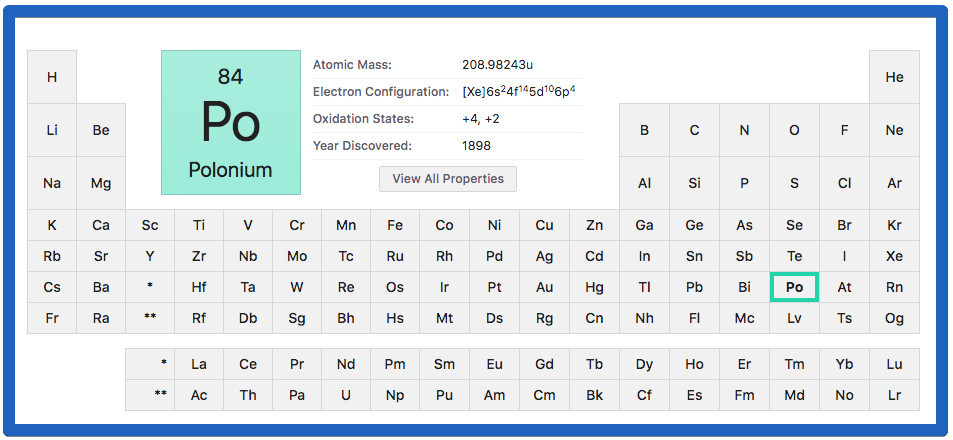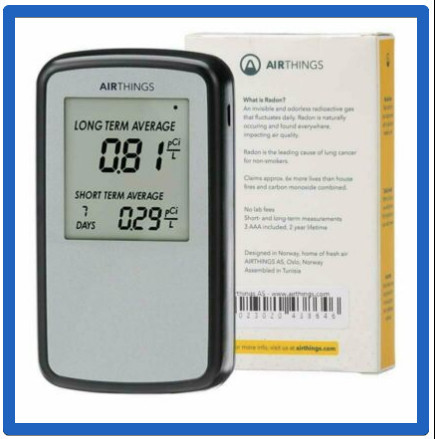It’s an established fact that smoking is the leading cause of lung cancer in the US. What isn’t commonly known is that exposure to radon is the second leading cause of deaths attributed to lung cancer. In fact, it’s estimated that approximately 21,000 deaths annually are related to radon, which takes into account both smokers and non-smokers. Here are 10 facts about radon gas and lung cancer that could save your life.

Table of Contents
Radon Gas And Lung Cancer
1. Radon Is A Radioactive Gas Found In Rock And Soil
Radon is a ubiquitous radioactive gas that is odorless, tasteless, and colorless. It’s formed by the deterioration of radioactive elements found in rock and soil, including uranium, radium, and thorium, which moves into the atmosphere and water sources. Levels of radon are typically low in outdoor air and in bodies of water, such as lakes and rivers. Indoor air and underground water supplies, including well water, have been found to have much higher concentrations of radon.
Levels of gas are increased by the richness of the radon source itself, and by the degree of ventilation in relation to the vicinity of the source. Poorly ventilated areas have much higher concentrations of radon. The primary source of radon gas is the underlying soil, but the pressure within a building, and the materials used during construction, along with the gas and water supplies are also contributing factors. The amount of time spent in a building with high radon levels is obviously a significant issue, as well.
Disclaimer: This article is strictly for informational purposes only and is not intended to be used as medical advice.
2. Radon Gas Is The 2nd Leading Cause Of Lung Cancer
Radon circulating in the air is implicated in the development of lung cancer because the breakdown of gas forms minuscule radioactive elements called radon progeny, including polonium-214, polonium-218, and lead-214. These elements attach to particles in the air, that when inhaled are able to burrow into the lining of the lungs, where they emit radiation that can damage cellular DNA. DNA damage can then initiate the development and progression of cancer.
Decay products from radon are more dangerous than the gas itself because of the large degree of energy they emit, via alpha particles, which damage delicate tissue in the lungs. Due to the instability of radioactive elements, they either retain atomic energy in the nucleus of the cell or release it. Decay in the nucleus is what releases harmful radiation.
Smoking, in conjunction with radon gas exposure, doubles cancer risk. Radon alone, however, is responsible for an alarming number of deaths in people who have never smoked. Prior smokers are at increased risk, as well. Interestingly, it was Marie Curie, the famous Polish Chemist, who discovered polonium, also referred to as Radium F.
 Source: National Library of Medicine / PubChem
Source: National Library of Medicine / PubChem
3. You Can’t Totally Avoid Breathing In Radon
Since radon is found in both indoor and outdoor air, this means it’s impossible to entirely avoid breathing in radiation from radon. Fortunately, there are strategies you can implement to reduce your exposure. The most significant source of radon for the majority of people will be in their own homes. This is why it’s crucial to get levels of radon in your home tested to make sure they fall within safe limits.
You can do this by hiring a radon specialist or by ordering a DIY detection kit, which can purchased online or at your local hardware store. The Environmental Protection Agency recommends testing all living areas below the 3rd floor, including new residences that are supposedly resistant to radon. Visit this link on the EPA’s website to find a professional in your area.
4. Levels Of Radon Above 4.0 pCi/L Are Problematic
Radon levels are measured in units called picocuries per liter of air. The EPA recommends that steps be taken to lower radon if the annual average level is shown to be 4.0 pCi/L or higher. Readings between 2.7 and 4.0 p/Ci/L are considered fair if levels remain stable for a period of three months or longer. No action is necessary if levels are less than 2.7 pCi/L. Ideally, levels should be 0. Levels should be monitored daily to get a reliable reading because radon levels fluctuate over time.
It is suggested to conduct a DIY short-term test initially, and if the results are elevated, to do a long-term, follow-up test to confirm the findings. If levels are found to be above safe levels, steps should be implemented to lower exposure. Short-term tests are conducted anywhere from three to 90 days, as opposed to long-term testing that lasts longer than 91 days. The latter will give a more complete picture as to the amount of radon gas that is present since levels fluctuate according to seasons and other factors.
5. Radon Gets Inside A Building Due To Pressure
Radon gas can get inside your home and build-up due to pressure. This is because the pressure surrounding the foundation of your house, along with the pressure in the soil, exceeds the pressure inside the house. This discrepancy of pressure acts like a vacuum to suction radon out of the ground, distributing it up into your living areas via cracks in the foundation. The gas then gets trapped indoors, gradually building to levels that are dangerous.
Levels of radon are higher in the winter because cold temperatures increase the amount of warm air that is emitted from buildings. This scenario causes indoor air to be under negative pressure, enabling radon to be released from the soil beneath the foundation. Rainy and cold conditions increase radon levels because wet and frozen soil impede the flow of radon into the air where it can dissipate, allowing higher concentrations to enter your home.
To make matters worse, houses and offices are poorly ventilated in the winter, enabling air to be recirculated. Buildings that are “energy efficient” further compound the problem by trapping toxic air inside. All of these conditions make winter the ideal time to test radon levels because they will likely be at their highest.
6. Underground Miners Are At Risk Of Radon Poisoning
Radon is an inert radioactive gas that is able to migrate from rocks and soils to enclosed areas, making underground mines a perfect breeding ground for radon toxicity. Studies conducted on miners have demonstrated that exposure to decay products from radon does cause lung cancer. Miners are exposed to low levels of radon on a daily basis sometimes for years and even decades.
Data compiled from 11 studies performed on miners exposed to radon concluded that about 40% of all lung cancer deaths were likely due to radon progeny exposure. 70% of these deaths occurred in people that had never smoked. 39% of deaths occurred in smokers. 10% of all lung cancer deaths in the USA were attributed to indoor radon exposure.
It was concluded that reducing radon levels in homes where it exceeded EPA guidelines, could potentially reduce lung cancer related deaths from 2-4%, resulting in 5,000 lives being spared. However, simultaneous exposure to diesel exhaust and arsenic must be taken into account due to the modification they exert on the radon-effect.
7. Early Signs And Symptoms Of Lung Cancer
Exposure to radon is doubly concerning, because since you can’t see it or smell it, you’ll have no idea that you’re breathing in toxic air. Nor will you have any symptoms to alert you that you’re inhaling high levels of a carcinogenic gas. Exposure to radon, and the resulting damage to lung tissue, can take 5 to 25 years to develop into cancer. Early symptoms include:
- Shortness of breath
- Wheezing and hoarseness
- A persistent cough or coughing up blood
- Chest pain
- Pain that is accentuated by laughing or coughing
- Frequent bouts of pneumonia or bronchitis
- Weight loss
- Exhaustion
- Loss of appetite
8. Radon Is Also Linked To Childhood Leukemia
Although, radon is strongly linked to lung cancer, studies have also found associations between childhood leukemia and exposure to radon gas. These epidemiological studies, however, have not been consistently demonstrated even though data indicates that environmental exposure to radon does correlate to an increased incidence of overall leukemia and acute lymphoblastic leukemia (ALL).
9. DIY Tips To Reduce Radon Gas Levels
While it’s strongly advised to seek professional help in reducing radon levels, there are strategies you can implement yourself to increase your safety if obtaining a mitigation system is prohibitive in terms of cost. Be sure and test levels beforehand so you can determine if the steps you’re taking are working. Continue doing what you’ve been doing if radon levels decrease after following the steps below. If levels remain the same or continue to climb, you’ll want to get a mitigation system installed.
1. Adequately ventilate basements and crawlspaces: Open all windows as often as possible, weather permitting. Radon dissipates when it’s exposed to air so any gas that has become trapped will dissipate once the area is ventilated with fresh air. Keep in mind, humidity increases radon levels. This means that if it rains, or humidity levels rise and the windows are closed, gas levels will increase.
2. Caulk and seal all suspect areas to prevent radon leakage: Since radon enters building through cracks in the foundation, cement, sump pumps, and flooring, you’ll want to caulk and seal all faulty areas to prevent gas leakage. Any gaps that are fixed will have a positive impact on future readings, even if you aren’t able to seal them all.
3. Seal off HVAC systems: If you have an HVAC system with cold-air return registers in your basement, you’ll want to seal them off in order to decrease the amount of basement air that gets into your air ducts, thereby preventing radon gas from entering your living spaces.
4. Address the pressure in your house: The lower the pressure is in your house, the more easily radon can enter. Fireplaces and wood stoves are problematic because they reduce internal pressure, allowing more gas to get suctioned into your house. Keep areas well ventilated that have fireplaces and stoves. Alternatively, you can also install a system that will permanently supply outdoor air to the area.
Radon Monitor Detectors And Fans
It’s a good idea to test radon levels in your home using a home radon detector: The Corentium home radon detector by Airthings is a compact, easy-to-use, handheld device that gives reliable radon readings within 24 hours. Track levels of radon over long periods of time for more accurate results.
You can also use a radon monitor detector that enables you to track gas levels using an app on your smart phone. Quick and reliable data is displayed in a graph format that is easy to understand.
The Radon Eye is up to 20 times more sensitive than other radon detectors thanks to its pulsed ionization mechanism that allows for accurate gas detection.
Using a radon mitigation fan is another safety option you can implement. Fans inhibit radon leakage, are ultra-quiet and energy-efficient. The RadonAway is a 6″ mitigation fan
10. There Are Two Types Of Radon Mitigation Systems
There are two types of radon mitigation systems. Suction systems are designed to create negative air pressure at the lowest level in the home to remove gas. These systems range in price from $1,000 to $3,500.
Pressurization systems operate by continuously blowing air into the lowest levels of a building to prevent radon from entering in the first place. Pricing for a unit costs between $1,000 to $2,500, with yearly electrical costs running between $200 to $500.
Here’s a great article that will teach you how to save money by installing a mitigation system yourself.
Key Points
Smoking is the number one cause of lung cancer in the US, with radon exposure being the second leading cause. Exposure to secondhand smoke is the third leading cause of lung cancer. Radon toxicity is responsible for approximately 21,000 deaths annually, with 2,900 occurring in nonsmokers. Essentially, when you breathe in radon, you are inhaling radiation. This is why it’s so closely tied to cancer.
The EPA has stated that one out of every three homes has dangerous levels of radon gas. That’s an extremely sobering statistic. The degree of exposure, along with the duration of exposure, will determine the level of toxicity. Long-term exposure to high levels of radon significantly increases lung cancer risk. Testing is relatively inexpensive, especially considering the repercussions of not testing. Erring on the side of caution could save your life.
I would strongly advise getting your home tested by either performing a do-it-yourself test or by hiring a remediation specialist. If radon levels are found to be high, get busy implementing the steps highlighted above. If you’re in the process of building a home, you can have a radon professional work in conjunction with your builder to install a radon mitigation system. This one step will be pivotal in keeping you and your family safe.
Did you know that radon gas could gas lung cancer? Let me know in the comments:)


Thank you so much for sharing with us this informative article. The main theme of this article – radon and lung cancer – is timely. You have laid out facts in an easy to understand way.
Radon gas is largely responsible for lung cancer so my family and I checked our home with a specialist to find out how much is here. The amount of gas we have is very small which can be said to be safe. So I would say for those who still want to make your home safe, you must determine the amount of this gas by an expert and fix it properly.
Finally, I enjoyed reading your article and so I’d like to share your article in my Facebook group if that is okay.
Thanks for reading my post. Radon and its association to lung cancer is timely because many people correlate lung cancer primarily with smoking. Although, smoking is the number one cause, exposure to radon is the second leading cause – so the issue is not insignificant.
I’m sorry to hear that people in your family have cancer due to radon exposure. It’s important for everyone to get radon levels checked to reduce risk, and especially in light of the fact that you can’t see it or smell it.
Please do share my post on social media. Much appreciated:)